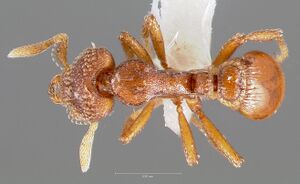Strumigenys alperti
| Strumigenys alperti | |
|---|---|

| |
| Scientific classification | |
| Kingdom: | Animalia |
| Phylum: | Arthropoda |
| Class: | Insecta |
| Order: | Hymenoptera |
| Family: | Formicidae |
| Subfamily: | Myrmicinae |
| Tribe: | Attini |
| Genus: | Strumigenys |
| Species: | S. alperti |
| Binomial name | |
| Strumigenys alperti Fisher, 2000 | |
Specimens have been found in rainforest and montane rainforest habitats. Collections have been from litter samples, rotten logs, under moss and a pitfall trap.
Identification
Bolton (2000) - A member of the sylvaini complex in the Strumigenys dexis-group. S. alperti is immediately separated from all other members of the group by its unique possession of a transverse band of scale-like hairs, made up of 4-5 rows, on the cephalic dorsum immediately behind the clypeus. S. alperti can be separated from Strumigenys carolinae by the presence of reticulate-punctate sculpture on the promesonotum. S. alperti and carolinae together can be separated from other two members of the sylvaini-complex by the following characters.
S. alperti + carolinae 1 Erect short simple hairs entirely absent from dorsal surfaces of head, alitrunk, waist segments and first gastral tergite.
2 Head dorsolaterally with broad scale-like hairs present.
3 Disc of postpetiole completely surrounded by spongiform tissue in dorsal view.
S. wardi + Strumigenys sylvaini 1 Erect short simple hairs present on dorsal surfaces of head, alitrunk, waist segments and first gastral tergite.
2 Head dorsolaterally without scale-like hairs.
3 Disc of postpetiole not surrounded by spongiform tissue in dorsal view, with anterolateral angles and anterior halves of sides free.
Keys including this Species
Distribution
Distribution based on Regional Taxon Lists
Malagasy Region: Madagascar (type locality).
Distribution based on AntMaps
Distribution based on AntWeb specimens
Check data from AntWeb
Countries Occupied
| Number of countries occupied by this species based on AntWiki Regional Taxon Lists. In general, fewer countries occupied indicates a narrower range, while more countries indicates a more widespread species. |

|
Estimated Abundance
| Relative abundance based on number of AntMaps records per species (this species within the purple bar). Fewer records (to the left) indicates a less abundant/encountered species while more records (to the right) indicates more abundant/encountered species. |

|
Biology
|
Castes
Worker
Images from AntWeb
   
| |
| Worker. Specimen code casent0005892. Photographer April Nobile, uploaded by California Academy of Sciences. | Owned by CAS, San Francisco, CA, USA. |
Nomenclature
The following information is derived from Barry Bolton's Online Catalogue of the Ants of the World.
- alperti. Strumigenys alperti Fisher, in Bolton, 2000: 639 (w.q.) MADAGASCAR.
Unless otherwise noted the text for the remainder of this section is reported from the publication that includes the original description.
Description
Worker
Holotype. TL 2.3, H L 0.60, HW 0.52, CI 87, ML 0.14, MI 23, SL 0.27, SI 52, PW 0.31, AL 0.64. Characters of sylvaini-complex. Lateral margin of clypeus, upper scrobe margin, and leading edge of scape each fringed with a row of curved spoon-shaped hairs. Clypeal dorsum with short, anteriorly-directed spatulate hairs. Dorsum of head immediately behind clypeus with a transverse band of scale-like hairs, arranged in 3-4 rows, these hairs similar in size to those fringing the upper scrobe margins. Similar but somewhat more spoon-shaped hairs are also numerous on the dorsal surfaces of the occipital lobes, but they are absent from the median posterodorsal area of the head. There are no standing hairs of any description on the head, alitrunk, postpetiole or first gastral tergite. Eye conspicuous, with 4-5 ommatidia in the longest row. Promesonotal dorsum finely and densely reticulate-punctate, the sculpture fading posteriorly on the propodeal dorsum. Pleurae glassy smooth. Petiole node broader than long in dorsal view, finely reticulate-punctate and with several pairs of posteriorly curved decumbent spatulate hairs. Disc of postpetiole completely surrounded by spongiform tissue; disc with weak longitudinal striolate sculpture on each side of a smooth median strip. Basigastral costulae moderately developed, extending for some distance onto the first gastral tergite.
Paratypes. TL 2.4, HL 0.60-0.61, HW 0.52-0.54, CI 85-89, ML 0.14-0.15, MI 23-25, SL 0.27-0.28, SI 50-54, PW 0.31-0.32, AL 0.66-0.68 (2 measured). As holotype.
The non-paratypic material shows greater size-variation than the type-series: HL 0.60-0.66, HW 0.51-0.58, CI 85-89, ML 0.15-0.17, MI 24-27, but otherwise matches all the critical diagnostic characters.
Type Material
Holotype worker, Madagascar: 17 km. W Andapa, Res. d'Anjanaharibe Sud, 875 m., 2.xi.1994, 14°45'27.9"S, 49°30'36.7"E, primary rainforest, nest in log under moss, 543.12969w (G. D. Alpert) (Museum of Comparative Zoology).
Paratypes. 1 worker and 1 queen (dealate) with same data as holotype but 543.12968q; 1 worker (gaster missing) with same data but 543.13484w (MCZ, The Natural History Museum).
References
- Fisher, B.L. 2000. The Malagasy fauna of Strumigenys. Pp. 612-696 in: Bolton, B. 2000. The ant tribe Dacetini. Memoirs of the American Entomological Institute. 65:1-1028. (page 639, worker described)
References based on Global Ant Biodiversity Informatics
- Bolton, B. 2000. The Ant Tribe Dacetini. Memoirs of the American Entomological Institute 65
- Fisher B. L. 2003. Formicidae, ants. Pp. 811-819 in: Goodman, S. M.; Benstead, J. P. (eds.) 2003. The natural history of Madagascar. Chicago: University of Chicago Press, xxi + 1709 pp.

